The Italian grandmas going viral with the art of making pasta
Italy’s rich culinary history is gaining new admirers thanks to a group of women, most in their 80s, who make traditional pasta dishes on YouTube. Carrying on a centuries-old custom of using simple ingredients and implements to prepare ‘sfoglie’ from scratch, the ‘Pasta Grannies’ are popularizing a time-honored practice, sharing regional recipes, and enjoying a moment of international acclaim

The mattarello – a long wooden rolling pin used to spread balls of pasta dough into thin and stretchy ovals on a pastry board – is like a Samurai sword forged in Okinawa and passed down from one generation to the next, carrying the secret of an ancient art. The tool is almost always made of cherry wood, because of its hardness and durability, and its tendency to absorb very little moisture. And the older the mattarello — the more it has been rolled and worked and worn in — the better the chances of success. This is also why the tool should never be washed with soap. It is a link in a chain of cultural history passed down through water and wheat, imprinted, like the spiral of Trajan’s Column, with the grooves of Italy’s rich culinary past.
Every sfoglina – a woman, usually in her middle or late years, who makes pasta by hand – has her own. Maria uses the same one her mother used; Leondina’s is “new” (only 30 years old) because she lost many of her belongings when she was forced to emigrate from the Abruzzo region with her family; Luisa’s is a 4-foot-long wooden roller with a red diamond inlayed on one of the handles, used to make the unusually large sfoglie that distinguish her unique technique, and that have won her first place in every contest she has entered. They are all grandmothers. But above all, they are the custodians of a tradition that appears to be at risk of dying with them.
Pasta in Italy, like rice in Spain, has always been a matter of geographic proximity. Each configuration of shapes, textures and ingredients is unique to the region of the pasta-maker, to her economic and cultural environment, and to her family and their customs. But there is a collective and ancestral process shared by every sfoglina – a cultural connection formed from water, flour, and egg – that dates back two millennia, to the Etruscan civilization, and conveys with it the history of each place. It is a way of life that is born and reborn every day at dawn, carried on by the Italian grandmothers who embody it, who grow fewer in number every year.
The potential extinction of this ancient art was what inspired the creation of “Pasta Grannies,” a project started by British cookbook author Vicky Bennison nine years ago, which now boasts a YouTube channel with over 900,000 subscribers and social media accounts with a total of nearly 2.5 million followers. The project is just now publishing its second book, whose author is also in conversation with several streaming platforms to start working on a series. Admittedly, the formula is hard to beat: The combination of food, social media and grandmothers has created a hurricane of views capable of steering any algorithm in its direction. “During the pandemic, we grew a lot,” Bennison tells me over the phone, just back home after a tour of the US. “People told me that it was comforting, that when they’re feeling stressed or anxious, they search for the videos and it helps them feel better.”
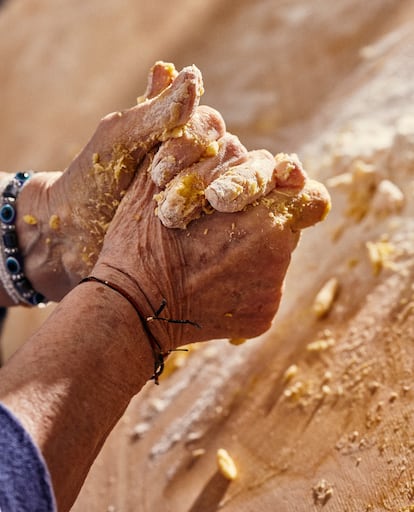
Pasta Grannies is a mix of historiography and cultural conservation, communicated via social media. The first time Bennison made a video and posted it on YouTube, she chose to feature the grandmother who runs the supermarket in the village where she has a home, in central Italy’s Marche region. The gestures and movements, the pre-dawn preparation of ingredients, the grandmother’s stories, the food – it was magnetic. From there, it eventually grew into a full-scale business operation, which is now managed by Bennison and several full-time employees. “I noticed that the only people making pasta by hand on a daily basis were older women, and I thought, someone has to record them,” Bennison says. “The domestic tradition was changing, dying out, and it was such a vital practice for that generation. So in the beginning, it was an attempt to collect and document as many types of pasta as possible. But the project evolved, because people came to us for the pasta, but stayed for the grandmas,” Bennison says. Notably, most of the channel’s viewers are between the ages of 25 and 35.
The subject of this experiment in culinary anthropology has a very clear center of gravity. For a long time, Italy’s Emilia-Romagna region has been the breadbasket of the country. With the third highest per capita income in the country (€35,300), it is still Italy’s main agricultural region. It is where Prosciutto di Parma (Parma ham) and parmigiano reggiano cheese – perhaps the country’s most iconic, unique and valuable product in markets abroad – come from. But the region’s flavors and aromas, as always in Italy, change radically as you travel from one town to the next. Driving from village to village, we watch out the window as the slender bell-tower spires typical of the region pass us by.

The Via Emilia, a road built in 189 BC that still, to this day, connects the northern Italian city of Piacenza with Rimini, on the Adriatic coast, cuts across the Romagna region and passes through Faenza, a town of 58,700 inhabitants. Each part of the region is like its own country; nothing is the same – not the accent, not the dialect, not the culinary tradition. Only one thing unites the halves: the history of pasta, like the history of so many things that have kept Italian families on their feet, has a woman’s name.
Maria Argnani, 88, has a family tree with roots that run deep here in Faenza, where she carries on a tradition that reveals the tremendous differences that set the town’s pasta apart from other recipes from the same region. It is 9.30am and the romagnola chicken broth has been simmering over an open flame on the old stove in her kitchen for five hours. Maria, like all the grandmothers who continue to work in this way, is up before dawn to begin preparing her cappelletti in brodo: a cheese-filled pasta cooked in an extremely delicious broth (the best way to enjoy a delicate pasta filling). The chicken – which, before ending up in the pot, was kept by one of Maria’s best friends – was alive just a few hours ago. The two grandmothers managed to get her down from the tree where she had fled when she sensed her fate. Then they killed and skinned the hen themselves.
For the pasta, Maria chose cappelletti (“little hats” in Italian), which in the Romagna area are almost always filled with cheese. The preparation seems simple, but to make it right requires a special kind of gastronomic alchemy. It takes Maria only two and a half seconds to shape each pasta piece, using just three fingers and sticking the edges together naturally by pressing gently with her fingertips. “It’s essential that the dough doesn’t dry out while you start shaping them, otherwise you won’t be able to pinch them together,” she explains. Maria, raised by a family of farmers, has been a master of the art of sfoglia since she was just five years old. “My mother had severe hip pain and I had to start cooking for the family,” she recalls. “Well, that and a lot of other things. Before school we would go to feed the cows, then the pigs. And after all the chores, we would walk to school: five kilometers in wooden clogs. What state do you think we were in once we got to class?” In those days, her house had a few grape vines and a couple of chickens. But most of what they grew they either sold or traded for other products. World War II brought German looting and Allied bombs, which made everything worse, she says. At home, they went hungry, and Maria’s mother would always keep a pot of garlic simmering on the stove. “[Cappelletti] is a high-calorie food, a subsistence food that poor families would make to survive,” she says. Now, it’s is mostly made for big holiday celebrations, like Christmas. Today, the whole house fills with a smell reminiscent of the holidays.
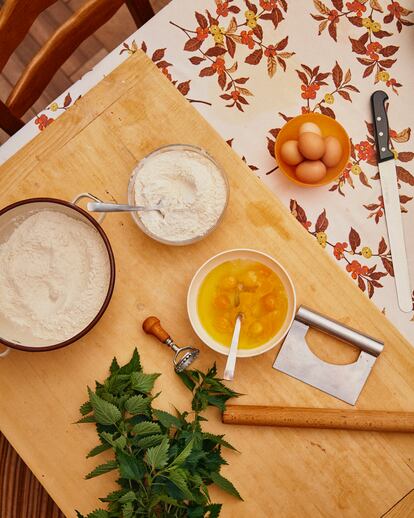
Maria places the “little hats” carefully on a tray. The pieces are soft and yellow and contrast sharply against the porcelain-white platter – a geometric and chromatic display that is at once pleasing and jarring. I watch Maria assemble her work, transfixed by so much beauty. When she is finished shaping the cappelletti, the pasta is immersed in a broth made from the freshly butchered hen, and as soon as they bob back up to the water’s surface, they are ready to eat. And so, without interruption, the food is transferred to a ceramic serving dish, made locally in Faenza, and served with a bottle of Sangiovese that by the end of the meal will be almost empty. It’s only 11am, but the life of a reporter – who luckily, today, does not have to drive – is often difficult, and one must sometimes make sacrifices in the name of journalism. Thankfully, we often meet people, like Maria, who make the sacrifice that much easier to bear.
Livia De Giovanni is also one of those people. She is an extraordinary cook, and is the person who helped Vicky Bennison, the creator of Pasta Grannies, find, convince and document the grandmothers and their work. “For me, it’s important to give visibility to all the people who maybe didn’t have any before, in their own families,” De Giovanni says. “The women, the grandmothers and mothers, they always gave everything taking care of the household, and almost never got the appreciation they deserved. And these are things that are being lost. So we try to find the oldest women we can, because that’s where the secrets are. What we’re doing now is what I would have wanted to do with my own grandmother, who is no longer alive. And the videos, which are like a kind of encyclopedia, are fundamental to this because everyone does it in a different way. In Italy, people eat their mother’s or grandmother’s pasta and they take it for granted. But these are things that, if you don’t take care of them, they’ll disappear.”
Many of these women, like most women of their generation, gave their lives to care for their families. And when their husbands died or their children left home, they held onto that work, and to the traditions they had cultivated. The chest freezer that Leondina Micolucci, 80, keeps in the entryway to her house is still full of bags of handmade pasta. For years, she made and sold her specialties to restaurants in Zattaglia, a village about 30 kilometers from Faenza nestled on one of the steep slopes of Romagna, in the foothills of the Apennine Mountains. At times, she was producing more than 50 kilos a day to supplement the income she made from her meager pension. Most of the restaurants in the province are run by women like Leondina, and in every kitchen there is a freezer located behind the stove, so that the time it takes to transfer the pasta to the boiling water is a short as possible.
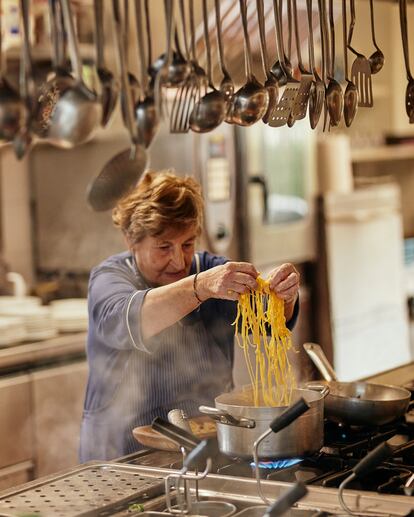
Leondina’s dining room table is an improvised culinary workbench, where today she is just starting to knead the dough to the background noise of one of her favorite TV shows. Her rolling pin is only 30 years old – not one of the oldest, because many of her grandmother’s belongings were lost when her family moved here from another region, and they had to buy new ones. Leondina was born farther south, in the region of Abruzzo, and moved north to Emilia-Romagna at age 14, when her family, fleeing poverty, bought a piece of land here. “I learned to cook between slaps,” she says. “By the time I was six, I already knew how to make the sfoglia. My family were farmers,” she says, as the dough turns green from the nettles she picked from her field this morning, which she adds to give color and aroma to the cheese-stuffed tortelli. “We use it because it’s cheaper than spinach and has a special smell.” The nettles must be soaked and blanched to remove the plant’s small spines.
After 30 minutes of kneading, the dough begins to firm up. First, Leondina forms a circle with the water and flour, then she adds the eggs to the center, one by one — eight eggs, one for each portion. The tortelli begin to take shape as she cuts the sfoglia into strips, then squares. She takes a pinch of filling, rolling it into a little ball, then using her right hand and two fingers of her left hand, she places the cheesy stuffing onto each of the squares, which she then folds over and seals, one by one, until each green tortello is ready for the pot. It is slow and laborious work, which she manages to make less lonely by chatting with her sister-in-law, who lives next door. But Leondina’s way of life, like that of so many other sfogline, may well be lost with her. Her daughter, who is 55, works in a factory nearby and doesn’t have time to help her mother in the kitchen. “Sometimes she even buys pasta at the supermarket! It makes me so angry.”
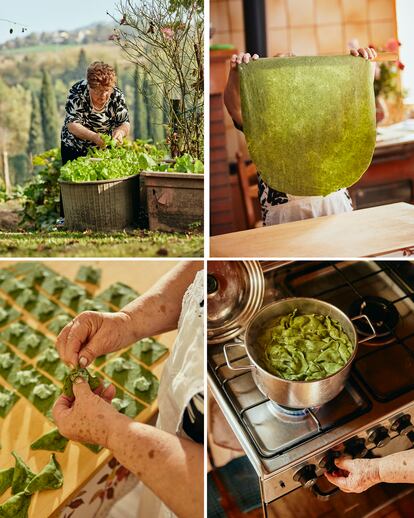
Sfogline are increasingly rare to find in Italy. Some, like Luisa Peduli, 57, took up the tradition a little later in life, or through less typical paths, but are just as committed to the practice. Luisa, who also lives in Faenza, perfected her technique by taking several culinary courses, and now works in two local restaurants. Her rolling pin – a huge, 4-foot-long roller capable of ironing out the largest sfoglie in the region – did not come from her mother, but she did inherit many memories, and many pasta-making techniques. Overcooking the pasta and mixing it with leftover meat or tomatoes to make sfoglia lorda, or “dirty pasta,” for example – a dish that solves every grandmother’s eternal puzzle: how to feed more people with less money. Today, though, Luisa prepares tagliatelle, a two-color noodle dish that serves as a base for a meat ragù (known in other parts as bolognese). A simple dish, but amazing.
Sfoglia can be used to make many types of fresh pasta. The key to a perfect dough sheet – the base that can then be shaped into many types of pasta – is the thickness, as well as one’s mastery over the rolling pin. The dough sheet can be round or oval, depending on the region, but it must be perfectly uniform in thickness. It should also be thin, but not break or perforate when handled. It must have a certain adherence, but be soft to the touch. And it must be elastic – something that can only be achieved thanks to that modern-day demon we call gluten – and have a final moisture content that does not exceed 30%. Luisa is an expert, and an absolute spectacle to watch with the rolling pin.
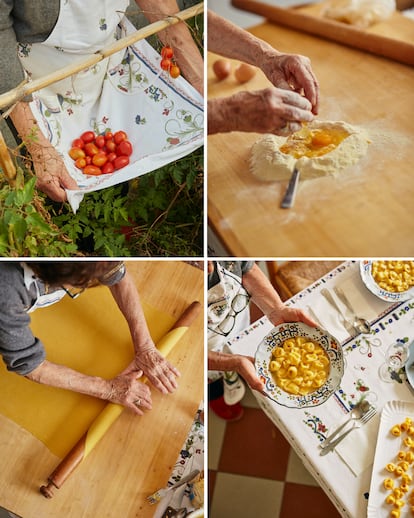
Practically every region in Italy has its own dish and its own process for making it, and every grandmother has in her culinary arsenal a combination of three to four pastas and as many, or more, sauces. A map of the entire country could be drawn based on each region’s distinct pasta dish: pizzoccheri (Valtellina), spatzle (Trento), bigoli (Venice), maltagliati (Emilia-Romagna), fescheirol or tajarin (Piedmont), trofie (Liguria), pisarei (Piacenza), passatelli (Romagna), pici and pappardelle (Tuscany), testaroli (Tuscany and Liguria), tonnarelli (Lazio), cavatelli (Apulia), yorecchiette (Apulia and Basilicata), and so on.
Monte Porzio Catone, the village where Imperia Fiorelli lives, is located in Castelli Romani, a smattering of hill communities about 30 kilometers from Rome. She is 86 years old and, like most sfogline, she gets up every day at 3am. She turns on the lights in her family home in silence, then goes down to the kitchen of the osteria, or small restaurant, they run (Il Monticello) to begin preparing the impasto. Eggs, flour, water, and a lot of strength concentrated in the palms and wrists, until the dough turns yellow and elastic. Imperia usually works alone for several hours in the morning, until the sun starts to rise and her children arrive. But on some Saturdays, around 4am, her grandson Edoardo appears through the small door leading to the courtyard. “Sometimes he takes a video of me working. He records something and then goes to sleep.” And then she keeps cooking. Her daughter, who has started to help with the business end of the operation, is just waking up.
Another element that sets Roman recipes apart is the use of vegetables. The region is one of the rainiest in Europe, and many pasta dishes, such as the one Imperia is preparing this morning, are based on seasonal harvests. Today, she is picking romanesco broccoli from her impressive vegetable garden. Then she grabs a bottle of white wine, made nearby in the commune, or municipality, of Frascati, and a piece of guanciale, a cured meat and a key ingredient in Roman cuisine (don’t be caught here comparing it to pancetta: it’s not the same). Guanciale is a cut of pig cheek, cured for three weeks with salt, pepper and, sometimes, paprika. It is an ingredient you will find in nearly every Roman classic – gricia, carbonara, matriciana – and the trick is in the frying process: turning the stove on and off repeatedly so that it doesn’t burn. Imperia cuts the cubes of meat, toasts them, then tosses them with the broccoli, sautéed in wine. Voilà.
The pasta she kneads and cuts with precision are fettuccine, the Roman version of tagliatelle. The noodles are flat and wide, and she has made them in two different colors: classic yellow and green, dyed with nettle juice. Imperia’s mother passed on the nettle-dying trick to her, and now she has taught it to her daughter Angela, who runs the restaurant. But her granddaughter, who is 23 years old and stops by the kitchen to give her grandma a kiss as she cooks, has yet to take the baton. “She asks me to teach it to her... I tell her, it’s very simple: the day you wake up at four in the morning with me is the day you learn how,” Imperia jokes. She wants it to be a choice for her granddaughter, not an imposition forced on her by history and tradition. And today, Imperia’s choice, after working since 3am cooking several recipes and putting up with a clumsy reporter and a perfectionist photographer, is to put the rolling pin down, sit in her garden, and read Il Fatto Quotidiano, her favorite newspaper. What the rest of us do with her tradition is no longer her concern.
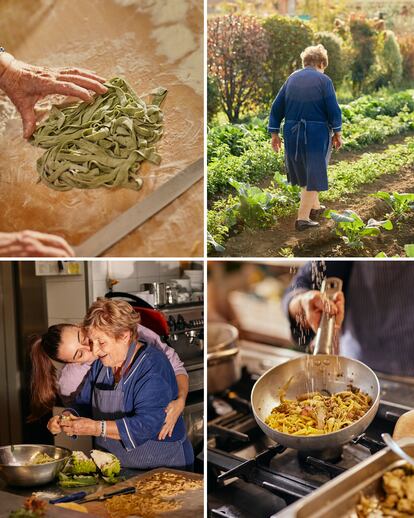
Imperia Fiorelli
Fettuccine with broccoli and 'guanciale'
Imperia Fiorelli’s fetuccine has all the elements of the typical Roman version, but is somewhat lighter than classic dishes like cacio e pepe or carbonara. The handmade pasta is mixed with the flavors of broccoli and guanciale, the key ingredient of most Roman recipes. As do most of the grandmothers, Imperia measures her proportions by eye.
Ingredients:
→ For the pasta: 400 grams of flour, 4 eggs.
→ For the sauce: 1 head of broccoli, 100 g guanciale, broccoli leaves (blended with water), 30 g peccorino, white wine (for cooking the garlic and broccoli).
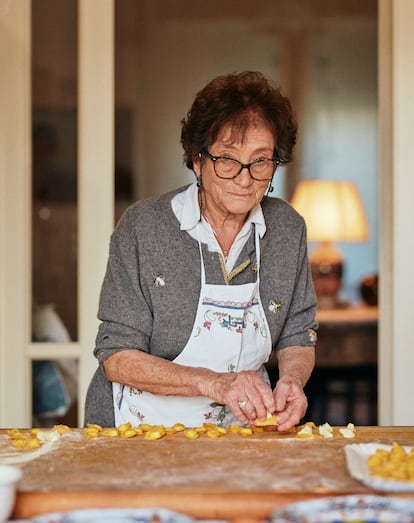
Maria Argnani
‘Cappelletti in brodo’
This pasta dish is typically made during the holidays and for Christmas. The added time required for its preparation makes it less suited for daily meals. The broth also needs to simmer for about four hours. Cappelletti are the Romagnola variant of tortellini. They are larger (tortellini must be small enough to fit at least three in one large spoon) and are usually filled with cheese rather than meat.
Ingredients:
→ For the pasta: 3 eggs, 300 g flour (70% type 00 wheat flour and 30% course grain semolina).
→ For the filling: 150 g ricotta cow cheese, 150 g grated parmigiano reggiano, 150 g bucciatello (a fresh local cheese), 1 egg, nutmeg.
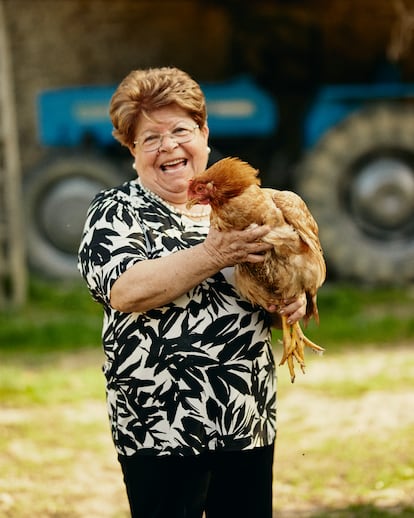
Leondina Micolucci
Nettle ‘tortelli’ with butter and sage
Nettle tortelli is a delicate dish. The filling, prepared by Leondina Micolucci with cheese and nettles, has an intense flavor, so it’s best to enjoy them with the simple flavors of butter and fresh sage. The brightly colored pasta, which turns green from the nettle juice, should not be mixed with tomatoes or other sauces.
Ingredients:
→ For the pasta: 120 g washed and boiled nettles, 3 eggs, 400 g type 00 flour, 1 tablespoon extra-virgin olive oil.
→ For the filling: 500 g ricotta cheese (a blend of cow and sheep varieties), 150 g cleaned and boiled nettles, 150 g grated parmigiano Reggiano, nutmeg and salt.
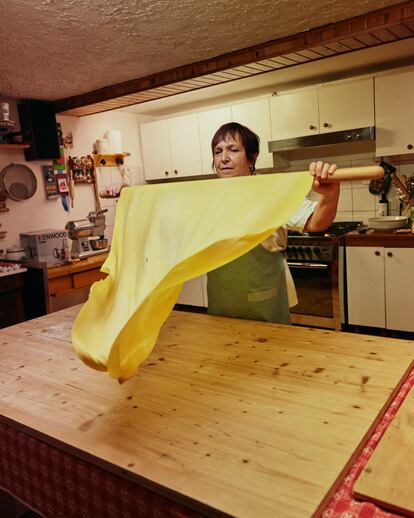
Luisa Peduli
‘Tagliatelle’ with meat ragù
Meat ragù is a classic of Emilia-Romagna cuisine. In Bologna, and in the rest of the world, the sauce would be called Bolognese. But in this region, they simply use the term ragù. It is a dish that, unlike many stuffed pastas, is eaten on a daily basis. But its preparation, at least using Luisa Peduli’s method, is not as simple.
Ingredients:
→ For the pasta: 500 grams of flour and 3 eggs.
→ For the sauce: Sauté celery and carrots, add sausage and minced veal meat. As soon as the meat turns grey, add a half cup of red wine (in this case, Sangiovese). When the wine evaporates, add passata (a mild tomato sauce), salt and nutmeg, then let it simmer for about two hours.
Tu suscripción se está usando en otro dispositivo
¿Quieres añadir otro usuario a tu suscripción?
Si continúas leyendo en este dispositivo, no se podrá leer en el otro.
FlechaTu suscripción se está usando en otro dispositivo y solo puedes acceder a EL PAÍS desde un dispositivo a la vez.
Si quieres compartir tu cuenta, cambia tu suscripción a la modalidad Premium, así podrás añadir otro usuario. Cada uno accederá con su propia cuenta de email, lo que os permitirá personalizar vuestra experiencia en EL PAÍS.
¿Tienes una suscripción de empresa? Accede aquí para contratar más cuentas.
En el caso de no saber quién está usando tu cuenta, te recomendamos cambiar tu contraseña aquí.
Si decides continuar compartiendo tu cuenta, este mensaje se mostrará en tu dispositivo y en el de la otra persona que está usando tu cuenta de forma indefinida, afectando a tu experiencia de lectura. Puedes consultar aquí los términos y condiciones de la suscripción digital.
More information
Últimas noticias
Trump clarifies who is ultimately in charge in Venezuela: ‘Me’
Maduro pleads not guilty before the federal court in New York: ‘I am still the president of Venezuela’
A new test can detect Alzheimer’s from a finger prick
UN team enters Sudanese city of El Fasher after paramilitary massacre: ‘It’s like a ghost town’
Most viewed
- Gilles Lipovetsky: ‘If you want to live better and fall in love, take Prozac, don’t look to philosophy’
- Alain Aspect, Nobel laureate in physics: ‘Einstein was so smart that he would have had to recognize quantum entanglement’
- Alvin Hellerstein, a 92-year-old judge appointed by Bill Clinton, to preside over Maduro’s trial in New York
- Why oil has been at the center of Venezuela-US conflicts for decades
- Cuba confirms death of 32 of its citizens in the US attack against Venezuela











































